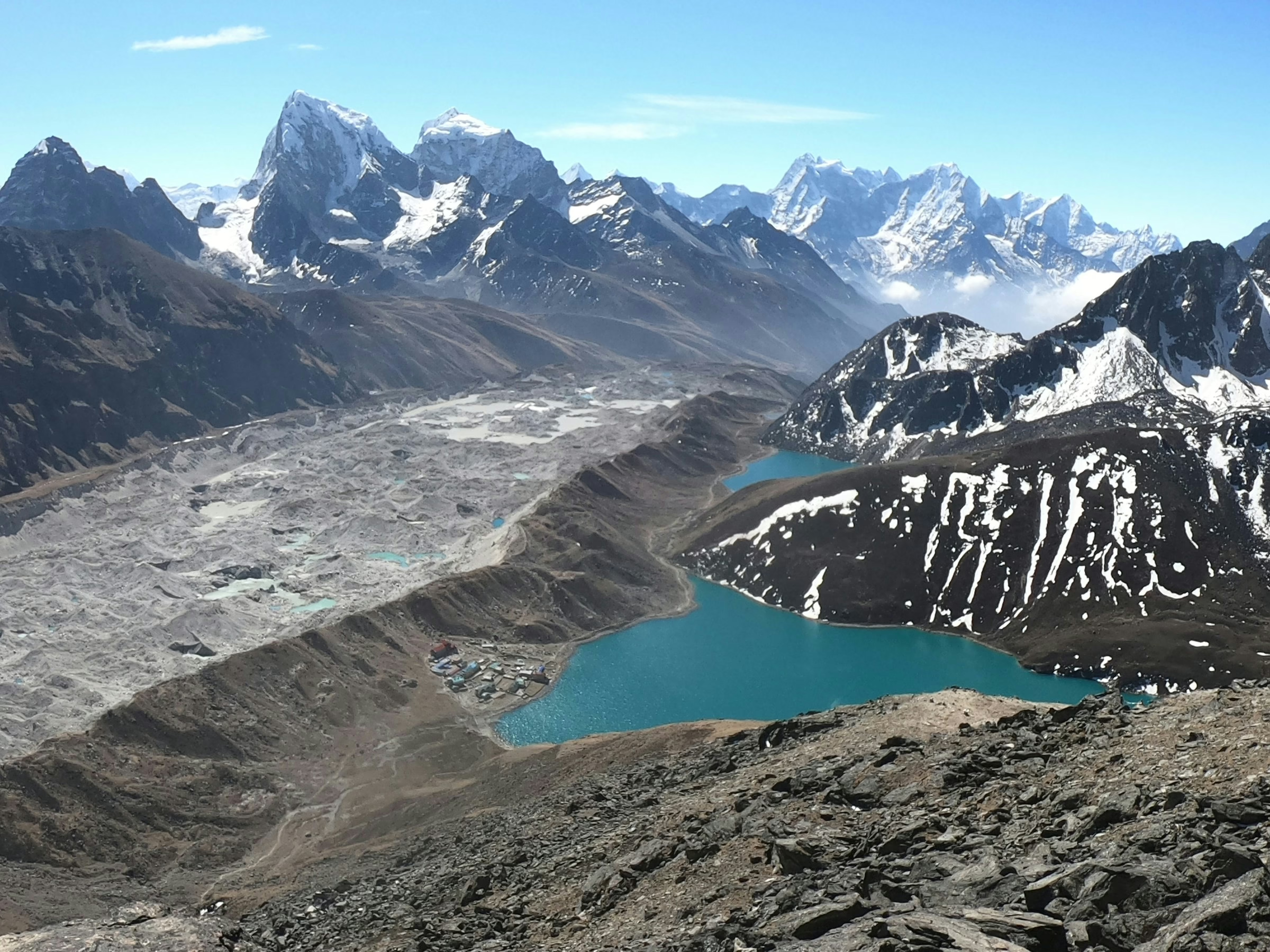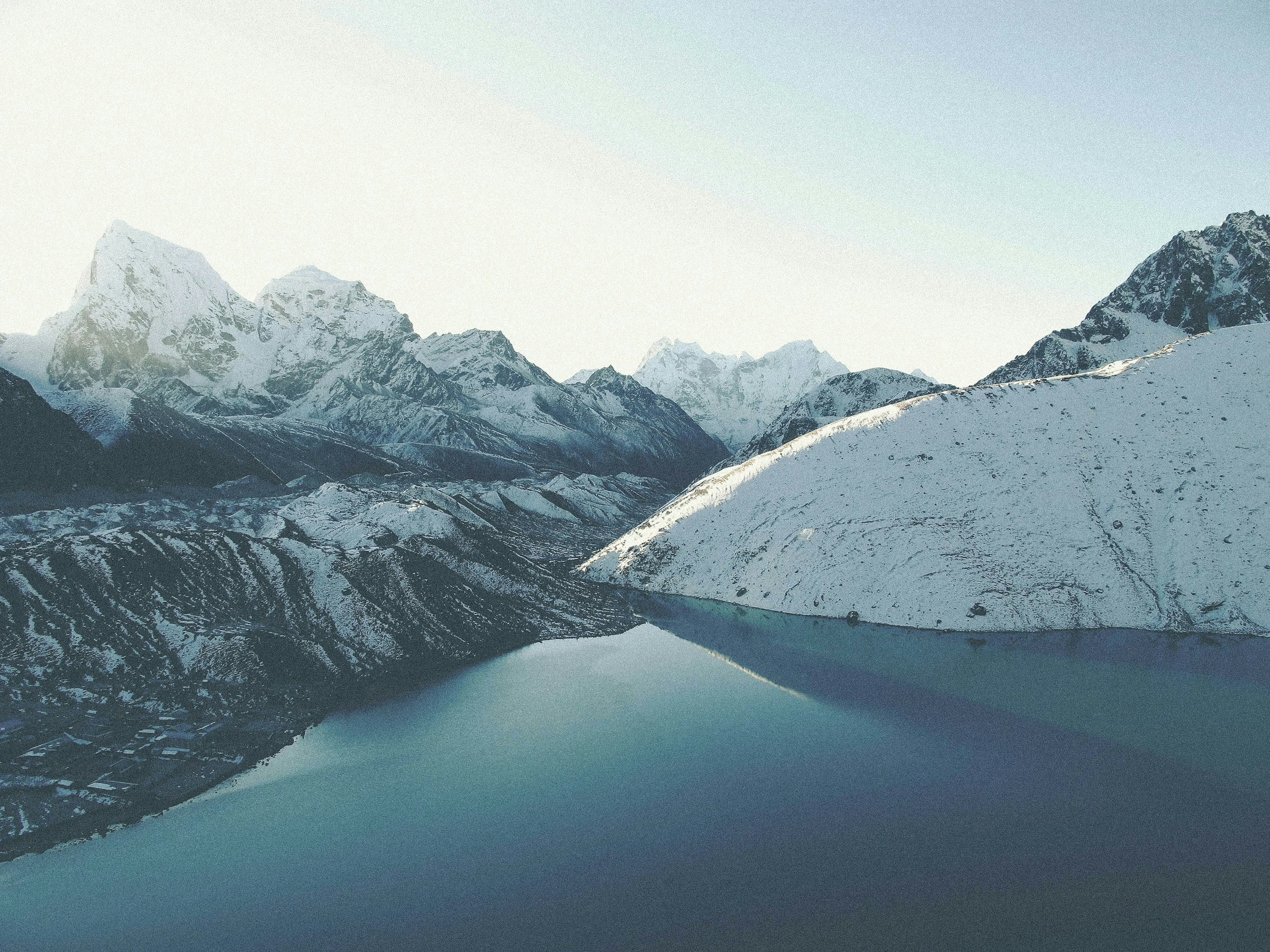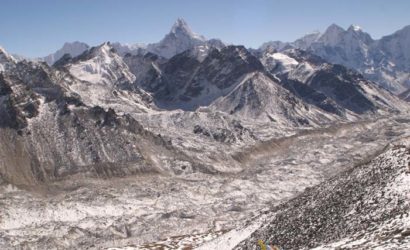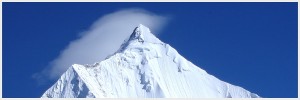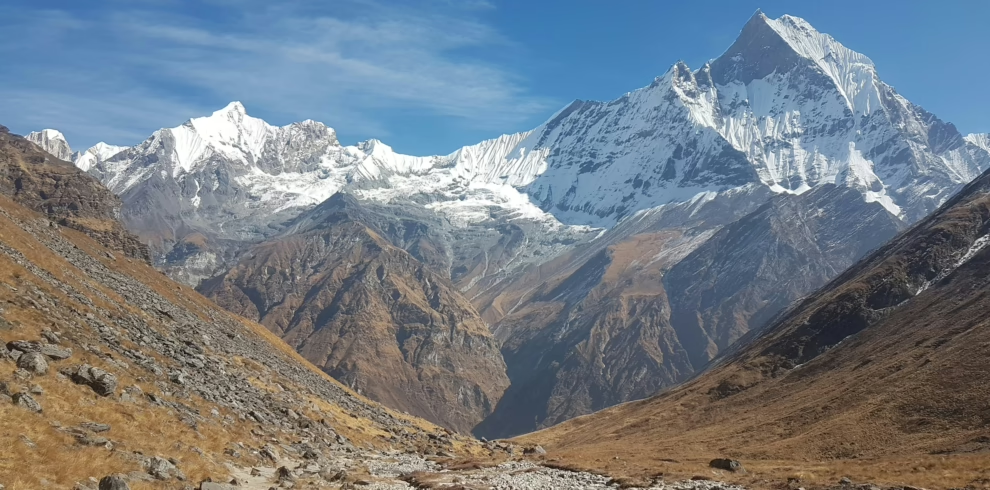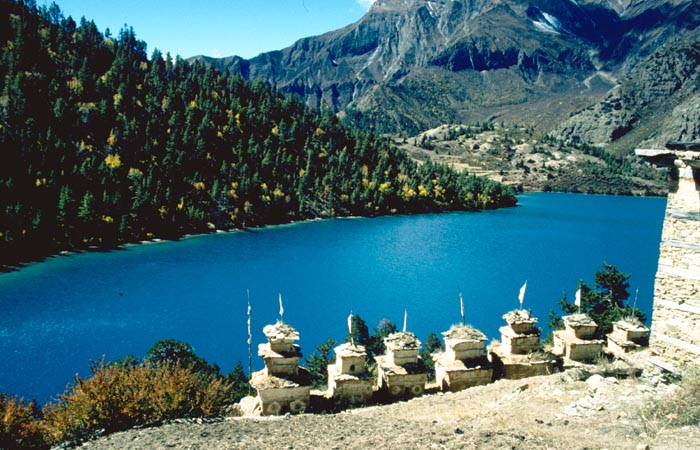Embark on an unforgettable adventure with the Gokyo Chola Pass Trek via EBC, a challenging yet incredibly rewarding journey through some of the most awe-inspiring landscapes in the Everest Region. This trek will lead you across the Khumbu Glacier, the largest glacier in the Himalayas, and offer you a rare chance to witness the raw power and beauty of nature firsthand. Along the way, you’ll also encounter the breathtaking Ngozumpa Glacier, the biggest in the Nepalese Himalayas, adding to the trek’s allure.
One of the standout features of this trek is crossing the challenging Chola Pass. At 5,420 meters, the pass rewards trekkers with panoramic views of the majestic Himalayas. While crossing the pass requires a solid level of fitness and prior trekking experience, the spectacular vistas and sense of achievement make every step worth it. Of course, Everest Base Camp (EBC), the iconic destination for trekkers and climbers aiming for the summit of Mount Everest, is a key highlight of this adventure.
This trek is not for the faint of heart; it demands endurance, fitness, and preparation. However, the reward is one of the most extraordinary experiences you’ll ever have. You’ll traverse some of the world’s most stunning scenery and conquer one of the Himalayas’ most challenging crossings.
The best times to tackle the Gokyo Chola Pass Trek via EBC are from September to November and March to May, when clear skies and pleasant temperatures make for ideal trekking conditions. For a smoother experience, it’s highly recommended to hire a local guide and porter. Their knowledge of the region and logistical support will make your journey more enjoyable and insightful.
Overview
Experience some of the world’s most stunning scenery and cross one of the Himalayas’ most challenging routes—worth every effort. The best months for the Gokyo Chola Pass Trek via EBC are from September to November and March to May, offering clear skies and comfortable temperatures. We recommend hiring a local porter and guide to assist with logistics and share valuable insights about the journey.
The 16-day Gokyo Chola Pass via EBC itinerary begins with a scenic flight from Kathmandu to Lukla, followed by a trek to Phakding, where you’ll stay overnight. The next day, you’ll head to Namche Bazaar, the gateway to Mount Everest, where you’ll spend an extra day for acclimatization and to explore Sherpa culture. Enjoy stunning morning views of Mount Everest, Ama Dablam, Lhotse, Khantenga, Thamserku, and other peaks.
The trek continues from Namche to Tengboche, where you’ll get even more impressive views. Then, as you ascend to Dingboche, Lobuche, Gorakshep, and Everest Base Camp, you’ll pass through deep valleys, monasteries, and viewpoints with breathtaking panoramas. The highlight is the climb to Kala Patthar for unparalleled views of snow-capped mountains.
After Kala Patthar, your trek moves toward Dzongla, where you’ll cross the challenging Cho La Pass in two days. Upon reaching Gokyo, you’ll be welcomed by the stunning Gokyo Lake, a revered site for both Buddhists and Hindus. The next day, hike up Gokyo Ri for sweeping views of the entire Everest region. On your return to Namche Bazaar, you’ll pass through Khumjung, the largest Sherpa village in the region.
The trek concludes as you descend from Namche to Phakding and back to Lukla. From there, catch a flight back to Kathmandu.
At Green Lotus Trekking Pvt. Ltd, we offer a well-planned EBC Trek with Gokyo Chola Pass itinerary, ensuring an unforgettable experience. Bookings for 2025 and 2026 are open. We can also customize the trek based on your time, budget, and fitness level. For more details on costs, feel free to contact us.
Before starting the trek, familiarize yourself with the altitude and route using the Gokyo Chola Pass Trekking via EBC map.
Benefits of Booking the Gokyo Chola Pass Trek via EBC with Us:
- Airport pickup and drop-off (international and domestic)
- Green Lotus Trekking duffle bag
- Green Lotus Trekking T-shirt
- Free Everest Base Camp Trek map
- Oximeter to monitor blood oxygen levels
- Medical kit for emergencies
- Free excess luggage storage at Green Lotus Trekking store during the trek
What to Expect from Gokyo Chola Pass Trekking via EBC?
The Gokyo Chola Pass Trek via EBC offers a challenging yet rewarding experience, taking you through some of the most stunning landscapes in the Everest region. Starting in Lukla, the trek leads through Sagarmatha National Park, home to Mount Everest, and past the sparkling Gokyo Valley’s glacial lakes. A highlight is summiting Gokyo Ri for panoramic views of Everest and surrounding peaks.
A key feature of the trek is crossing the Khumbu Glacier, the largest in the Himalayas, and the Ngozumpa Glacier. The Everest Base Camp (EBC) offers views of the Khumbu Icefall, a stunning glacial valley surrounded by towering peaks. From EBC, you’ll ascend to Kala Patthar for spectacular mountain vistas.
The trek continues through the challenging Chola Pass at 5,420 meters, rewarding trekkers with sweeping views of the Himalayas. Although demanding, the effort is worth the breathtaking scenery and the experience of crossing one of the Himalayas’ toughest routes.
Along the way, you’ll encounter traditional Sherpa villages and monasteries, providing a glimpse into the unique culture of the region. The ideal trekking months are from September to November and March to May, when weather conditions are clear and temperatures moderate.
Is Gokyo Chola Pass Trekking via EBC Suitable for You?
This trek is physically demanding and requires a good level of fitness and prior trekking experience. It’s not recommended for beginners, as crossing the Chola Pass at 5,420 meters requires physical preparation and mental resilience. The trek involves long days of hiking at high altitudes, which can lead to altitude sickness. Awareness of symptoms and precautionary measures are essential.
Trekking in a remote area with limited amenities means being self-sufficient. If you have trekking experience, are physically fit, and prepared for altitude, the Gokyo Chola Pass via EBC offers an unforgettable adventure.
Before undertaking the trek, consult with a doctor and ensure you’re prepared for the challenges. Hiring a local guide and porter is recommended to assist with logistics and provide valuable insights.
Preparation for Gokyo Chola Pass Trekking via EBC
Physical Fitness:
Prepare well in advance by incorporating cardio and strength training into your routine to build endurance.
Altitude Acclimatization:
Spend a few days acclimatizing in Kathmandu before the trek. Be aware of altitude sickness symptoms and take necessary precautions, such as taking Diamox or descending if needed.
Mental Preparation:
Be ready for the mental challenges, as the trek takes you through remote, rugged areas with few amenities.
Useful Information
Best Time for Gokyo Chola Pass Trekking via EBC
Spring Season (March, April, and May)
Spring is the ideal time for the Gokyo Cho La Pass via EBC Trek, with pleasant weather and vibrant surroundings. Temperatures at Base Camp range from 1°C to 12°C, offering a mild climate. The cool breeze makes the steep climbs more manageable, and the trails are dotted with blooming rhododendrons, wildflowers, and lush meadows. Wildlife sightings, including Himalayan Thar, snow leopards, and musk deer, are common. Longer days in April and May provide more time for rest before hikes. The excellent visibility allows trekkers to enjoy magnificent mountain views. However, temperatures rise towards the end of May, making it uncomfortably warm.
Autumn Season (September, October, and November)
Autumn is another great season, offering moderate weather and clear skies. The cool temperatures make the trek comfortable, and hikers can enjoy the stunning autumn foliage of orange, red, and yellow leaves. Peak season in October allows for clear views of peaks like Ama Dablam, Imja Tse, and Mount Everest. As the season progresses, temperatures drop below -12°C, signaling the approach of winter.
Food and Meal Availability
Food availability along the Gokyo Chola Pass Trek is generally good, with teahouses offering local and basic Western dishes.
- Breakfast: Pancakes, cornflakes, local bread, chapatti, porridge, eggs (fried, scrambled, boiled, omelet), toast, muesli with milk, hash browns, etc.
- Lunch: Similar to breakfast, including pancakes, cornflakes, eggs, toast, and more.
- Dinner: Includes soups (tomato, mushroom, garlic, vegetable, chicken) alongside the lunch menu.
- Drinks: Black tea, milk tea, lemon tea, ginger tea, mint tea, coffee (milk or black).
Accommodation
In Kathmandu, you’ll stay in a three-star hotel for two nights. During the trek, accommodations are typically in teahouses, which offer basic lodging with modest amenities. Rooms often have one window, wood-paneled walls, and foam-covered beds. Most teahouses use a central burner for heat, with some offering electric charging for a small fee. Hot showers are available in some places, but not all. It’s recommended to book double rooms, as single rooms may be hard to find during peak seasons.
Difficulty
The Gokyo Chola Pass Trek is physically demanding, especially with steep ascents, glacial moraines, and high altitudes. The trek involves long days of climbing and descending, which can quickly deplete energy reserves. Challenges include:
- Altitude Sickness: Common due to rapidly changing air pressure and low oxygen levels. Symptoms include headaches, dizziness, nausea, and shortness of breath.
- Harsh Weather: The cold, dry air and low humidity can make the climb more challenging.
- Treacherous Terrain: The path over the Ngozumpa Glacier is rocky and difficult, and the Cho La Pass presents the risk of frostbite due to the extreme cold.
Travel Insurance
Travel insurance is mandatory for the Gokyo Cho La Pass Trek via EBC. Your insurance must cover medical emergencies, evacuation, and helicopter rescue up to 6,000 meters. Please submit your insurance details within a week of booking. Ensure your policy includes coverage for helicopter evacuation before purchasing.
Altitude Sickness and Remedies
Altitude sickness is common above 3,000 meters. Symptoms include headaches, fatigue, nausea, dizziness, and sleep issues. To prevent it:
- Stay hydrated and avoid alcohol.
- Maintain a healthy diet and avoid rushing the ascent.
- Consider carrying Diamox to help with acclimatization.
- If symptoms appear, either rest or descend to a lower altitude.
Packing List and Gear
Proper gear is essential for a successful trek. Below is a suggested packing list:
- Clothing: Backpack, hiking boots, down jacket, windproof jacket, thermal wear, gloves, hat, sunglasses.
- Other Gear: Sleeping bag, water bottle, trekking poles, gaiters, micro-spikes, hand sanitizer, torch, toiletries, and medical kit.
- Additional Items: Prescription medications and any other personal necessities.
Safety and Guide Services
Green Lotus Trekking prioritizes your safety, ensuring that our guides are well-trained in wilderness first aid. Our experienced trek leaders are prepared to assist with altitude sickness and ensure your well-being throughout the journey. We also monitor the cleanliness of meals and accommodations, and provide necessary equipment and first aid.
Booking Procedure
Green Lotus Trekking is a government-approved operator, recognized by the Nepal Mountaineering Association (NMA) and the Trekking Agency Association of Nepal (TAAN). To book, a 10% deposit is required. After booking, please submit your passport, passport-size photos, travel insurance, and flight details within a week. Payments can be made via bank transfer, Western Union, or online. Upon arrival in Nepal, you can pay by cash, bank transfer, or credit card.
Highlights
- Enjoy a scenic flight from Kathmandu to Lukla, following in the footsteps of Tenzing and Hillary to Everest Base Camp and Kala Patthar.
- Experience stunning views of rolling hills, charming villages, and lush meadows.
- Explore Buddhist temples and immerse yourself in the unique Sherpa culture and customs.
- Discover wildlife and birdlife in Sagarmatha National Park.
- Visit the historic Tengboche Monastery, the largest and oldest in the region, and offer prayers.
- Witness breathtaking close-up views of snow-capped peaks, icefalls, and rugged slopes, along with ancient Chortens, Gompas, colorful Mani walls, and prayer wheels.
- After admiring views from Kala Patthar and Gokyo Peak, explore Gokyo Lakes and the Ngozumpa Glacier.
- Trek iconic locations like Everest Base Camp, Kala Patthar, Cho La Pass, Gokyo Lake, and Gokyo Ri.
- Enjoy tranquil walks through the lush trails of Sagarmatha National Park and Gokyo Valley.

